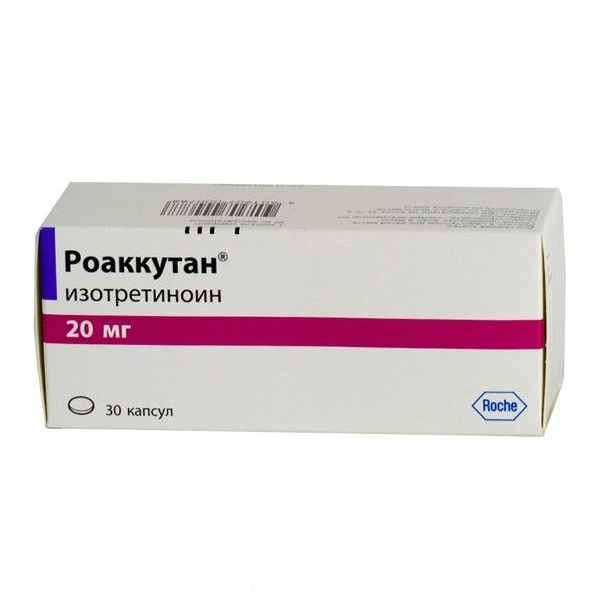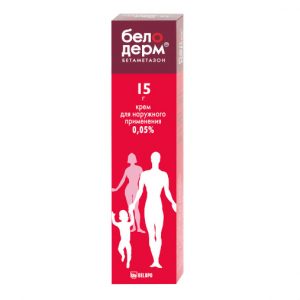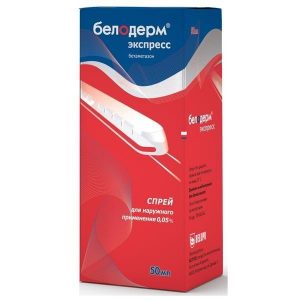Description
Latin name
DALNEVA
Release form
Capsules.
Packing
30 pcs
Pharmacological action of
Roaccutane – a regeneration stimulator, retinoid for systemic treatment of acne
Isotretinoin, the active substance of Roaccutane, stereoisomer of fully trans retinoic acid (tretinoin).
It has a specific anti-seborrheic effect in severe forms of acne (acne) that are not amenable to other types of therapy.
The mechanism of action of the drug is not fully understood, but it was found that the improvement in the clinical picture of the disease is associated with a dose-dependent decrease in the activity of the sebaceous glands and a decrease in their size, which is confirmed by histological studies.
In addition, the anti-inflammatory effect of isotretinoin on the skin has been proven.
Indications
Severe forms of acne (nodular-cystic, conglobate acne or acne with a risk of scar formation).
Acne not amenable to other types of therapy.
Contraindications
Pregnancy, lactation, liver failure, hypervitaminosis A, severe hyperlipidemia, concomitant tetracycline therapy.
Hypersensitivity to the drug or its components.
Children under 12 years old.
Special instructions
Roaccutane should be prescribed only by doctors, preferably dermatologists, who are experienced in the use of systemic retinoids and who are aware of the risk of teratogenicity of the drug. Both male and female patients must be given a copy of the patient information leaflet.
In order to avoid accidental effects of the drug on the body of other people, donor blood should not be taken from patients who receive or shortly before (1 month) received Roaccutane.
It is recommended to monitor liver function and liver enzymes before treatment, 1 month after its start, and then every 3 months or as indicated. A transient and reversible increase in hepatic transaminases was noted, in most cases within normal values. If the level of hepatic transaminases exceeds the norm, it is necessary to reduce the dose of the drug or cancel it.
You should also determine the level of lipids in fasting serum before treatment, 1 month after the start, and then every 3 months or as indicated. Typically, lipid concentrations are normalized after a dose reduction or drug withdrawal, as well as dieting. It is necessary to control a clinically significant increase in the level of triglycerides, since their rise above 800 mg / dl or 9 mmol / l may be accompanied by the development of acute pancreatitis, possibly with a fatal outcome. With persistent hypertriglyceridemia or symptoms of pancreatitis, Roaccutane should be discontinued.
In rare cases, patients receiving Roaccutane described depression, psychotic symptoms, and very rarely suicidal attempts. Although their causal relationship with the use of the drug has not been established, special care must be taken in patients with a history of depression and all patients should be monitored for depression during treatment with the drug, if necessary referring them to the appropriate specialist. However, the withdrawal of Roaccutane may not lead to the disappearance of symptoms and may require further observation and treatment by a specialist.
In rare cases, at the beginning of therapy, exacerbation of acne is noted, which disappears within 7-10 days without dose adjustment.
A few years after the use of Roaccutane for the treatment of dyskeratosis with a total course dose and duration of therapy higher than recommended for acne therapy, bone changes developed, including premature closure of the pineal growth zones, hyperostosis, calcification of ligaments and tendons. Therefore, when prescribing the drug to any patient, you should first carefully evaluate the ratio of possible benefits and risks.
Patients receiving Roaccutane are advised to use moisturizing ointment or body cream, lip balm to reduce dry skin and mucous membranes at the beginning of therapy.
During post-marketing monitoring, the use of the Roaccutane preparation described cases of severe skin reactions, such as erythema multiforme, Stevens-Johnson syndrome, toxic epidermal necrolysis. These phenomena can be serious and lead to disability, life-threatening conditions, hospitalization or fatal outcome. Patients receiving Roaccutane need careful monitoring to identify severe skin reactions and, if necessary, resolve the issue of drug withdrawal.
Against the background of taking Roaccutane, pain in the muscles and joints, an increase in serum creatinine phosphokinase, which may be accompanied by a decrease in tolerance to intense physical activity, are possible.
Avoid deep chemical dermabrasion and laser treatment in patients receiving Roaccutane, as well as within 5-6 months after treatment due to the possibility of increased scarring in atypical places and the occurrence of hyper- and hypopigmentation. During treatment with Roaccutane and for 6 months after it, it is impossible to carry out hair removal using wax applications because of the risk of detachment of the epidermis, the development of scars and dermatitis.
Since some patients may experience a decrease in visual acuity, which sometimes persists even after the end of therapy, patients should be informed about the possibility of this condition, Encouraging them to exercise caution when driving at night. The state of visual acuity must be carefully monitored.
Dry conjunctiva of the eyes, clouding of the cornea, impaired night vision and keratitis usually disappear after discontinuation of the drug. With dry mucous membranes of the eyes, you can use applications of a moisturizing eye ointment or artificial tear preparation. It is necessary to observe patients with dry conjunctiva for possible development of keratitis. Patients complaining of vision should be referred to an ophthalmologist and consider the advisability of canceling Roaccutane. In case of intolerance to contact lenses, glasses should be used during therapy.
Limit exposure to sunlight and UV rays. If necessary, use a sunscreen with a high protective factor of at least 15 SPF.
Rare cases of the development of benign intracranial hypertension ( ² Ñpseudotumor of the brain ² Ñ), including with combined use with tetracyclines. In such patients, Roaccutane should be withdrawn immediately.
During therapy with Roaccutane, inflammatory bowel disease may occur. In patients with severe hemorrhagic diarrhea, Roaccutane should be immediately withdrawn.
Rare cases of anaphylactic reactions that occurred only after previous external use of retinoids are described. Severe allergic reactions dictate the need for drug withdrawal and close monitoring of the patient.
High-risk patients (with diabetes, obesity, chronic alcoholism or impaired fat metabolism) during treatment with Roaccutane may require more frequent laboratory monitoring of glucose and lipids.
If you have or suspect diabetes, a more frequent definition of glycemia is recommended.
Composition
One capsule contains:
isotretinoin 20 mg
excipients:
soybean oil,
beeswax yellow,
soybeans hydrogenated oil,
soybeans partially hydrogenated oil
capsule shell:
glycerol 85%,
gelatin,
Carion 83 (starch red potassium hydroxide, sulphate red sulphate, sulphate, sulphate ,
titanium dioxide (E171)
ink for inscription on the capsule:
shellac,
dye iron oxide black (E172)
it is possible to use the finished ink Opacode Black S-1-27794.
Dosage and administration of
Standard dosing schedule
Inside, with food, once or twice a day.
The therapeutic efficacy of Roaccutane and its side effects are dose dependent and vary in different patients. This dictates the need for individual dose selection during treatment.
Roaccutane treatment should be started with a dose of 0.5 mg / kg per day. In most patients, the dose ranges from 0.5 to 1.0 mg / kg body weight per day. Patients with very severe forms of the disease or with acne of the body may require higher daily doses of up to 2.0 mg / kg. Proven that the frequency of remission and the prevention of relapse are optimal when using a course dose of 120-150 mg / kg (per treatment course), therefore the duration of therapy in specific patients varies depending on the daily dose. Complete remission of acne is often achieved in 16-24 weeks of treatment. In patients who tolerate the recommended dose very poorly, treatment can be continued in a lower dose, but spend it longer.
In most patients, acne completely disappears after a single course of treatment. With a clear relapse, a repeated course of treatment with Roaccutane is shown in the same daily and course dose as the first. Since improvement can continue up to 8 weeks after discontinuation of the drug, a second course should be prescribed no earlier than the end of this period.
Dosage in special cases
In patients with severe renal impairment, treatment should be started with a lower dose (for example, 10 mg / day) and then increased to 1 mg / kg / day or as tolerated as possible.
Side effects of
Most side effects of Roaccutane are dose dependent. As a rule, when prescribing recommended doses, the ratio of benefit to risk, given the severity of the disease, is acceptable to the patient. Usually, side effects are reversible after dose adjustment or drug withdrawal, but some may persist after discontinuation of treatment.
Symptoms associated with hypervitaminosis A: dry skin, mucous membranes, including lips (cheilitis), nasal cavity (bleeding), larynopharynx (hoarseness of the voice), eyes (conjunctivitis, reversible clouding of the cornea and intolerance to contact lenses).
Skin and its appendages: rash, itching, erythema of the face / dermatitis, sweating, pyogenic granuloma, paronychia, onychodystrophy, increased growth of granulation tissue, persistent thinning of hair, reversible hair loss, fulminant forms of acne, hirsutism, hyperpigmentation, photosensitivity, photos skin injuries. At the beginning of treatment, exacerbation of acne may occur, lasting several weeks.
Musculoskeletal system: muscle pain with increased levels of CPK in serum or without it, joint pain, hyperostosis, arthritis, calcification of ligaments and tendons, other bone changes, tendonitis.
Central nervous system and mental sphere: impaired behavior, depression, headache, increased intracranial pressure ( pseudotumor of the brain : headache, nausea, vomiting, blurred vision, swelling of the optic nerve), seizures.
Sensory organs: isolated cases of visual acuity, photophobia, impaired dark adaptation (decreased twilight visual acuity), rarely – color perception disorder (after drug withdrawal), lenticular cataract, keratitis, blepharitis, conjunctivitis, eye irritation, optic nerve edema (as manifestation of intracranial hypertension) hearing impairment at certain sound frequencies.
Gastrointestinal tract: nausea, diarrhea, inflammatory bowel disease (colitis, ileitis), bleeding pancreatitis (especially with concomitant hypertriglyceridemia above 800 mg / dl). Rare cases of pancreatitis with a fatal outcome are described. Transient and reversible increase in hepatic transaminase activity, individual cases of hepatitis. In many of these cases, the changes did not go beyond the normal range and returned to the initial indicators during the treatment process, however, in some situations it was necessary to reduce the dose or cancel Roaccutane.
Respiratory organs: rarely – bronchospasm (more often in patients with a history of bronchial asthma).
Blood system: anemia, decreased hematocrit, leukopenia, neutropenia, increased or decreased platelet count, accelerated ESR.
Laboratory indicators: hypertriglyceridemia, hypercholesterolemia, hyperuricemia, a decrease in the level of high density lipoproteins, rarely hyperglycemia. During the intake of Roaccutane, cases of newly diagnosed diabetes mellitus were recorded. In some patients, especially those involved in intense physical activity, individual cases of increased activity of CPK in serum are described.
Immune system: local or systemic infections caused by gram-positive pathogens (Staphylococcus aureus).
Other: lymphadenopathy, hematuria, proteinuria, vasculitis (Wegener’s granulomatosis, allergic vasculitis), systemic hypersensitivity reactions, glomerulonephritis.
Drug interactions
Due to the possible intensification of the symptoms of hypervitaminosis A, the simultaneous administration of Roaccutane and vitamin A.
Since tetracyclines can also cause an increase in intracranial pressure, their use in combination with Roaccutane is contraindicated.
Isotretinoin can weaken the effectiveness of progesterone preparations, so you should not use contraceptives that contain small doses of progesterone.
Concomitant use with topical keratolytic or exfoliative acne treatments is contraindicated because of the potential for increased local irritation.
Overdose
In the event of an overdose, signs of hypervitaminosis A.
may occur In the first few hours after overdose, gastric lavage may be necessary.
Storage conditions
Do not store above 25 ° C, in a place protected from light and moisture.
Keep out of the reach and sight of children.
Shelf life
3 years.
Deystvuyushtee substance
Isotretinoin
Dosage form
capsules
Indications
Indications
Severe acne
F. Hoffmann-La Roche Ltd, Switzerland




